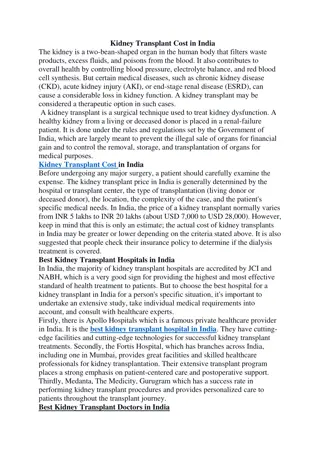Understanding the Anatomy of the Kidney
The lecture covers the shape, position, surface anatomy, external features, hilum and its contents, relations, internal structure, blood supply, lymph drainage, and nerve supply of the kidney. It also discusses the functions of the kidney, its position in the body, and the structures surrounding it. The content includes images and detailed explanations to help you grasp the essential information regarding the kidney's anatomy and functions.
Download Presentation

Please find below an Image/Link to download the presentation.
The content on the website is provided AS IS for your information and personal use only. It may not be sold, licensed, or shared on other websites without obtaining consent from the author. Download presentation by click this link. If you encounter any issues during the download, it is possible that the publisher has removed the file from their server.
E N D
Presentation Transcript
Color Code Important Doctors Notes Notes/Extra explanation Anatomy of the Kidney Please view our Editing File before studying this lecture to check for any changes.
Objectives By the end of this lecture you should be able to discuss the KIDNEY: Shape & Position. Surface Anatomy. External Features. Hilum And Its Contents. Relations. Internal Structure. Blood Supply Lymph Drainage. Nerve Supply.
Introduction Introduction o Every day, each kidney filters liters of fluid from the bloodstream. o Although the lungs and the skin also play roles in excretion, the kidneys bear the major responsibility for eliminating nitrogenous (nitrogen-containing) wastes, toxins, and drugs from the body. Functions of the kidney 1. Excretes most of the waste products of metabolism. 2. Controls water & electrolyte balance of the body. 3. Maintain acid-base balance of the blood. 4. Stimulate bone marrow for RBCs formation by Erythropoietin hormone. 5. Regulates blood pressure by Rennin enzyme. 6. Converts vitamin D to its active form.
Kidney Kidney Extra o Kidneys are reddish brown in color. o Lie behind the peritoneum (retroperitoneal*), on either side of the vertebral column on the posterior abdominal wall. o They are largely under cover of the costal margin. o The right kidney lies slightly lower than the left due to the large size of the right lobe of the liver. o The upper border of the right kidney is at the level of 11thintercostal space. o The upper border of the left kidney is a the level of the 11thrib. *retroperitoneal: only the front of the kidney is covered by peritoneum. Extra
Kidney Kidney o With contraction of the diaphragm (inspiration) the kidney moves downward as much as 2.5 cm. o The lateral border is convex, while the medial border is convex at both ends but its middle part shows a vertical slit called the hilum. o The hilum extends into a large cavity called the renal sinus. o The hilum transmits (from anterior to posterior) the renal vein, two branches of renal artery, ureter, and the third branch of renal artery from the front backward (V.A.U.A.) Medial Lateral
Kidney Kidney Covering From inward to outward: 1- Fibrous capsule: It is adherent to (surrounds) the kidney. 2- Perirenal fat : It covers the fibrous capsule. Perirenal fat Inside 3- Renal fascia: it encloses the kidneys and suprarenal glands (but in different compartments). 4- Pararenal fat : it lies external to the renal fascia, and forms part of the retroperitoneal fat. N.B. The last 3 structures support the kidney in position. floating kidneys ** pararenal fat Extra
Image result for youtube Kidney Kidney Structure o Each kidney has an outer cortex and an inner medulla. o Medulla is composed of about 12 renal pyramids. o The base of each pyramid is directed toward the cortex & its apex (the renal papilla) is projecting medially. o The cortex extends into the medulla between adjacent pyramids as the renal column. o Extending from the bases of the renal pyramids into the cortex are striations known as medullary rays. o The renal sinus within the hilum, contains the upper expanded end of the ureter: the renal pelvis. o Renal pelvis divides into two or three major calyces, which divides into two or three minor calyces.
Image result for youtube Kidney Kidney Posterior Relations Structures : Last intercostal space (11th) Costodiaphragmatic pleural recess Twelfth rib (The left kidney reaches up to the 11thrib ) 4 Muscles median to lateral : 1. Diaphragm 2. Psoas major muscle 3. Quadratus lamborum 4. Transversus abdominis 3 Nerves : 1. Subcostal nerve (T12) 2. Iliohypogastric (L1) 3. Ilioinguinal (L1) Extra
Kidney Kidney Posterior Relations Quadratus lumborum **You should know the location of each nerve and muscle **It s also important to know the normal location of the kidneys and the vessels, structures that surround it
Kidney Kidney Anterior Relations IMPORTANT! Peritoneum* Right kidney: Left kidney: 1- Right suprarenal gland 2- Liver 3- Descending (second) part of duodenum 4- Right colic flexure 5- Coils of small intestine 1- Left suprarenal gland 6-Descending colon 2- Stomach 7-colis of jejunum 3- Spleen 4- Pancreas 5- Left colic flexure * The peritoneum is a continuous transparent membrane which lines the abdominal cavity and covers the abdominal organs. The anterior relations of the kidney are either directly on the kidney or lie on the peritoneum. The ones in bold are separated from the kidney by the peritoneum.
Extra Explanation The course of the digestive tract: Oral cavity Pharynx Esophagus Stomach Small intestines Large intestines Anus The small intestines is divided into 3 parts: 1. Duodenum (the C-shaped part), 2. Jejunum (the coiled midsection), 3. Ileum (the last section) Extra The large intestines is also divided into 3 parts: 1. Cecum 2. Colon (ascending, transverse, descending) 3. Rectum. The part where the ascending colon curves to form the transvers colon is called the right colic flexure, and the part where the transverse colon curves to form the descending colon is called the left colic flexure. Extra
Only on the boys slides Kidney Kidney Segments Each kidney consists of 5 segments each having its own blood supply (4 anterior and 1 posterior): 1. Superior or Apical. 2. Anterior Superior. 3. Anterior Inferior. 4. Inferior or Basal. 5. Posterior or Caudal
Image result for youtube Kidney Kidney Blood Supply gives: Continues as: Lobar arteries Divides to: Interlobar arteries Divides to: Arcuate arteries Divides to: Interlobular arteries Divides to: segmental arteries Renal artery Afferent glomerular arterioles
Kidney Kidney Blood Supply Apical segmental artery The renal artery arises from the Aorta (abdominal Aorta) at the level of the second lumbar vertebra. Anterior superior segmental artery. Renal artery Each renal artery divides into five segmental arteries that enter the hilum of the kidney, four in front and one behind the renal pelvis. They are distributed to different segments of the kidney, branches : 1-Apical segmental artery. 2-Anterior superior segmental artery. 3- Anterior inferior segmental artery. 4-Caudal segmental artery. 5-Posterior segmental artery. Segmental arteries renal artery Anterior inferior segmental artery Posterior segmental artery Caudal segmental artery
Kidney Kidney Blood Supply Lobar artery arise from each segmental artery, one for each renal pyramid. Each lobar artery gives off 2 or 3 interlobar arteries. Lobar artery interlobar arteries The interlobar arteries run toward the cortex on each side of the renal pyramid. Interlobar arteries give off the arcuate arteries at the junction of the cortex and medulla. Inerlobar artery arcuate arteries The arcuate arteries give off several interlobular arteries. Arcuate arteries Interlobular arteries Interlobular arteries give afferent glomerular arterioles. Interlobular arteries Note: There is interLOBAR and interLOBULAR
Kidney Kidney Blood Supply o Each Nephron is associated with two capillary beds: 1. The glomerulus 2. The peritubular capillary bed o The glomerulus is both fed and drained by arterioles. o The afferent arteriole, which arises from an interlobular artery, is the "feeder vessel . o The efferent arteriole receives blood that has passed through the glomerulus.
Kidney Kidney Venous Drainage o Both renal veins drain to the inferior vena cava in front of renal artery. o The left is three times longer than the right (7.5 cm and 2.5 cm). So, for this reason the left kidney is the preferred side for live donor nephrectomy (when a living person donates a kidney). o It runs from its origin in the renal hilum, posterior to the splenic vein and the body of pancreas, and then across the anterior aspect of the aorta, just below the origin of the superior mesenteric artery. o The left gonadal vein enters the left renal vein from below, while the left suprarenal vein enters it from above but nearer to the midline. (the right gonadal and suprarenal veins drain directly into the IVC) o The left renal vein enters the inferior vena cava a little above the right renal vein. o The right renal vein is behind the 2ndpart of the duodenum and sometimes the lateral part of the head of the pancreas.
Kidney Kidney Supply Nerve Supply: Renal sympathetic plexus. (no parasympathetic) The afferent fibers that travel through the renal plexus enter the spinal cord in the: 10th, 11th, and 12th Thoracic nerves. Lymph Drainage: Lateral aortic lymph nodes around the origin of the renal artery. (Also called: para-aortic or lumbar lymph nodes)
MCQs MCQs 1- Which one of the following coverings does not play a role in supporting the kidney in position ? A. fibrous capsule B. renal facia C. pararenal fat D. perirenal fat Answer: A 4- Which one of the following gives afferent glomerular arteries ? A. Interlobar arteries B. Interlobular arteries C. Arcuate arteries D. segmental arteries Answer : B 5- Left renal vein runs behind which of the following veins? A. Gonadal vein B. Suprarenal vein C. Splenic vein D. Inferior vena cava Answer : C 2- The contains the upper expanded end of the ureter, the renal pelvis. A. Cortex. B. Medulla. C. Renal column. D. Renal sinus. Answer : D 6. Which of the following is related to the left kidney anteriorly with peritoneum? A. Left suprarenal gland B. Spleen C. Pancreas D. Descending colon 3- At which level does the renal artery arise ? A. 1stThoracic vertebra B. 2ndlumbar vertebra C. 1stlumbar vertebra D. 3rdlumbar vertebra Answer : B Answer: B
SAQs SAQs An obese person is undergoing a vigorous diet which one of his kidney coverings will be affected most and which condition will be apparent ? Answer : Pararenal fat will be affected most , (floating kidney) What are the capillary beds associated with Nephrons? Answer: Glomerulus and Peritubular capillary bed
Members: Yazeed Alsuhaibani Hamad alkhudairy Talal alhuqail Abdulmohsen alghannam Mohammed habib Khaled aldakheel Abdulaziz alsalman Essam alshahrania Leaders: Nawaf AlKhudairy Jawaher Abanumy anatomyteam436@gmail.com @anatomy436























